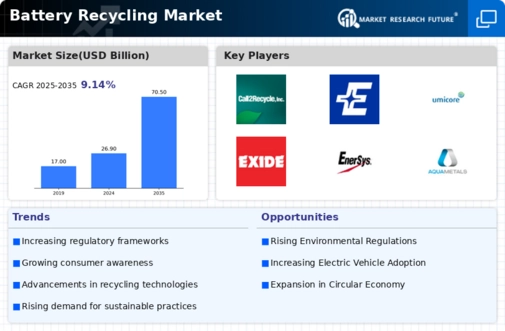Market Analysis
In-depth Analysis of Battery Recycling Market Industry Landscape
The global battery recycling market is set to reach US$ 54.20 BN by 2032, at a 11.70% CAGR between years 2023-2032. The battery recycling market is evolving dynamically with the movement of forces powered by several factors including environmental concerns, technology advancements, legal and political landscapes as well as consumer demand for sustainable practices. The increasing global concern about electronic waste (e-waste) and the environmental impact of spent batteries is one of the major market drivers. With increased perpetration of batteries in different industries, proper disposal and recycling has become vital. This has resulted in the growth of a vibrant battery recycling market that aims at recovering precious materials from used batteries with minimal environmental footprints associated with poor disposal. Government regulations and policies play a major role in determining the dynamics of battery recycling market. Countries have enacted strict laws regarding the dumps and recycling of batteries to address environmental pollution or health problems. Various regulatory frameworks like the European Union’s Battery Directive and U.S.’ Battery Act requires stringent handling of batteries for proper recycling. The adherence to these regulations encourages environmental responsibility but also defines the competitive context within which regulated battery recycling operates, promoting growth among compliant and certified facilities. Battery recycling’s market dynamics are fundamentally influenced by technological advancements. New and resourceful approaches as well as procedures are constantly formulated to enhance the effectiveness of recycling recourses. Valuable materials including lithium, cobalt nickel etc., are derived from the batteries using advanced technologies hydrometallurgical and pyrometallurgical processes. Battery recycling as an industry would only be a success if clean and economical technologies of recycling were to developed. The fast-growing usage rate of the electric vehicles (EVs) and battery storage solutions for renewable energy is greatly responsible to contribute towards dynamics within a market that recycles batteries. Rising demand for EVs and energy storage systems results in increased volumes of spent batteries. The growing demand for battery recycling services and technologies has introduced several new opportunities as well challenges for the market. Since the battery recycling industry is undergoing constant changes, stakeholders need to adapt to a changing environment and concentrate on expanding capacities of recycling production in order not lag new developments. Economic value of materials recovered from batteries also affects market dynamics. The cost of critical metals such as cobalt and lithium that are widely available in batteries makes recycling more favorable.












Leave a Comment